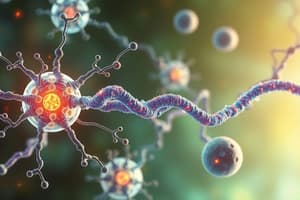Podcast
Questions and Answers
What is the primary action of PIP3 in insulin signaling?
What is the primary action of PIP3 in insulin signaling?
- Phosphorylating glycogen synthase
- Activating threonine 309
- Recruiting AKT/PKB to the membrane (correct)
- Inhibiting glucose uptake
Insulin signaling enhances glucose uptake in the brain through the Glut4 transporter.
Insulin signaling enhances glucose uptake in the brain through the Glut4 transporter.
False (B)
What enzyme is inhibited by PKB to promote glycogenesis?
What enzyme is inhibited by PKB to promote glycogenesis?
Glycogen synthase kinase (GSK3)
Insulin is secreted by the pancreatic _____ cells.
Insulin is secreted by the pancreatic _____ cells.
Which process is inhibited by insulin signaling in the liver?
Which process is inhibited by insulin signaling in the liver?
Match the following tissues with their insulin response:
Match the following tissues with their insulin response:
What role does FOXO1 play in insulin signaling?
What role does FOXO1 play in insulin signaling?
What is the effect of PKB on glucose transporter GLUT4?
What is the effect of PKB on glucose transporter GLUT4?
What triggers the activation of tyrosine kinase domain in the insulin receptor?
What triggers the activation of tyrosine kinase domain in the insulin receptor?
Dimerization of the insulin receptor leads to the autophosphorylation of serine residues.
Dimerization of the insulin receptor leads to the autophosphorylation of serine residues.
What creates high-affinity docking sites for intracellular signaling proteins in the insulin signaling pathway?
What creates high-affinity docking sites for intracellular signaling proteins in the insulin signaling pathway?
The insulin receptor is a _____ receptor composed of two intracellular and two extracellular domains.
The insulin receptor is a _____ receptor composed of two intracellular and two extracellular domains.
Match the following components of the insulin signaling pathway with their functions:
Match the following components of the insulin signaling pathway with their functions:
What is the role of phosphotyrosine-binding domains in the insulin signaling pathway?
What is the role of phosphotyrosine-binding domains in the insulin signaling pathway?
The autophosphorylation of kinase domains occurs only in the presence of calcium ions.
The autophosphorylation of kinase domains occurs only in the presence of calcium ions.
What does the insulin receptor dimerization promote?
What does the insulin receptor dimerization promote?
What is the primary function of ligands in cellular signaling?
What is the primary function of ligands in cellular signaling?
Receptor tyrosine kinases (RTKs) are primarily activated by phosphorylation.
Receptor tyrosine kinases (RTKs) are primarily activated by phosphorylation.
Name one example of a second messenger in cellular signaling.
Name one example of a second messenger in cellular signaling.
The process by which signals are converted to cellular responses is known as _____.
The process by which signals are converted to cellular responses is known as _____.
Match the cellular processes to their respective roles in insulin signaling:
Match the cellular processes to their respective roles in insulin signaling:
Which of the following is NOT a type of receptor mentioned in the context of cellular signaling?
Which of the following is NOT a type of receptor mentioned in the context of cellular signaling?
Insulin signaling primarily happens through receptor-mediated activation of second messengers.
Insulin signaling primarily happens through receptor-mediated activation of second messengers.
What do ligand-bound receptors undergo that leads to the activation of second messengers?
What do ligand-bound receptors undergo that leads to the activation of second messengers?
Flashcards are hidden until you start studying
Study Notes
Cellular Signalling Pathways
- Cellular signalling pathways allow extracellular signals to regulate gene expression impacting cell survival, division, differentiation, and apoptosis.
- Ligands (first messengers) such as hormones, neurotransmitters, and growth factors interact with receptors to initiate intracellular responses.
- Types of receptors include receptor tyrosine kinases (RTKs), G-protein coupled receptors (GPCRs), and ionotropic receptors, each activating second messengers like PIP3, Ca2+, and cAMP.
- Activated receptors trigger post-translational modifications leading to changes in gene expression or activity of target proteins.
Receptor Tyrosine Kinase (RTK) Pathways
- RTKs serve as high-affinity receptors for hormones, cytokines, and growth factors, with important roles in development and cancer.
- Activation of RTKs is often through dimerization, promoting receptor autophosphorylation on tyrosine residues.
- Phosphorylated regions create docking sites for intracellular signalling proteins, facilitating signal transduction and cellular responses.
- In specific cases, such as insulin receptors, dimerization enables close proximity of kinase domains to promote their activation through mutual phosphorylation.
Insulin Signalling Pathway
- The insulin receptor is a type of RTK that consists of two intracellular and two extracellular domains connected by disulphide bridges, forming a dimer of dimers upon activation.
- Insulin binding triggers autophosphorylation, activating downstream signalling via tyrosine kinase phosphorylating insulin receptor substrates (IRS).
- Phosphoinositide 3-kinase (PI3K) is activated by IRS, converting PIP2 to the second messenger PIP3, which facilitates further signalling by recruiting AKT/PKB.
Role of AKT/PKB in Insulin Signalling
- PIP3-dependent activation of AKT/PKB leads to:
- Translocation of glucose transporter GLUT4 vesicles to the plasma membrane, enhancing glucose uptake in muscle and adipose tissues.
- Inhibition of glycogen synthase kinase (GSK3), promoting glycogenesis and reducing blood glucose levels.
Insulin Signalling and Glucose Homeostasis
- Insulin is secreted by pancreatic beta cells, mediating glucose uptake and storage in response to blood sugar levels.
- In skeletal muscle and adipose tissue, insulin increases GLUT4-mediated glucose uptake and glycogen synthesis, while promoting lipid synthesis.
- Liver cells respond to insulin by downregulating gluconeogenesis and glycogenolysis and upregulating glycogen synthesis.
- Insulin does not regulate glucose uptake in the brain; instead, it utilizes the GLUT1 transporter for constant glucose uptake.
Contributions to Growth Control and Ageing
- Insulin signalling plays a crucial role in regulating organ size by influencing growth trajectories and cellular processes.
- Its regulation extends to ageing, linking metabolic functions to lifespan and healthspan.
Studying That Suits You
Use AI to generate personalized quizzes and flashcards to suit your learning preferences.



